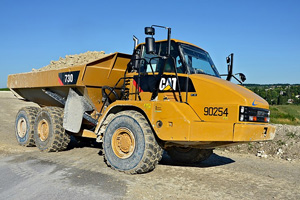

Meet Jason – No Experience, Big Dreams
This story is a fictionalised account inspired by the real experiences of students training at simulated mine environments.
Jason, 24, had never touched a piece of heavy machinery in his life. He’d spent the last few years bouncing between gig jobs, warehouse shifts, landscaping stints, the odd café role, but nothing that felt like a future. “I wasn’t afraid of hard work,” he says. “I just didn’t have a skill I could build on.”
That changed when he stumbled across a video showcasing civil machinery courses in Queensland. Big machines. Big opportunities. And training that promised not just a qualification, but the confidence to actually operate massive equipment in real-world settings.
For Jason, this wasn’t just another job course. It was a potential career reset. One that started not in a classroom, but on a simulated mine site, a controlled training ground designed to mirror the conditions, pace, and machinery of the real thing.
This is his story: from ground zero to operator-in-training.
Day 1: Confused, Intimidated, and Totally Hooked
The first thing Jason noticed as he stepped onto the training grounds wasn’t the size of the machines, it was the smell. Diesel in the air, dust on his boots, and the low growl of engines warming up in the distance. He adjusted his hi-vis vest, still stiff from the packaging, and tightened his helmet strap like he’d seen in the induction video.
To his left, a rigid haul truck towered above him like a building on wheels. Nearby, a trainer was walking someone through the controls of a front-end loader, their voices crackling over handheld radios. Jason knew these names now, kind of, but he couldn’t tell a loader from a dozer just yet. Everything was new. Everything was big.
In the classroom session, he was hit with a wave of unfamiliar terms: articulated dump truck, spotting protocols, three-point contact rule. Safety was paramount, that much was clear. But even with the encouragement of the instructors, Jason couldn’t shake the quiet thought in the back of his mind: Do I really belong here?
He wasn’t the only one feeling it. One of the other students, a woman in her 30s who used to work in retail, leaned over and whispered, “It’s like learning a new language, isn’t it?” Jason nodded. And that’s when the imposter syndrome cracked, just a little.
Because underneath the nerves, there was something else. Excitement. He was learning something real. Something useful. And even though he hadn’t touched the controls yet, he was hooked.
Week 2: From the Classroom to the Cab
 By the second week, the safety briefings, machine theory, and diagrams had started to click. Jason could now tell a grader from a dozer, and he was no longer second-guessing his answers during the morning toolbox talks. But the real test was coming, his first session behind the controls.
By the second week, the safety briefings, machine theory, and diagrams had started to click. Jason could now tell a grader from a dozer, and he was no longer second-guessing his answers during the morning toolbox talks. But the real test was coming, his first session behind the controls.
The instructor walked him up to a 20-tonne excavator, its arm resting still like a sleeping beast. Jason climbed the steps using the three-point contact rule drilled into him on Day 1, slid into the operator’s seat, and pulled the door shut with a satisfying clunk.
Inside the cab, it was surprisingly quiet. The world outside, the noise, the other trainees, the pressure, faded. It was just him, the controls, and the instructor’s voice crackling through the headset: “Alright Jason, ease into it. Let’s warm her up.”
The excavator rumbled to life beneath him.
His first few movements were clunky. Too much swing. Not enough lift. He stalled once and panicked when he forgot which joystick controlled the bucket. But no one yelled. The instructor was calm, talking him through every adjustment, and encouraging him to trust his instincts.
Around him, other students were getting their turns in different machines, water carts, front-end loaders, and Moxy trucks. They’d exchange stories over lunch, comparing mistakes and breakthroughs, celebrating the little wins. “I nailed the figure eight today!” one shouted with a grin. Jason laughed, because just yesterday, that had felt impossible.
This was no longer just theory. This was movement. Power. Control.
And for the first time in a long time, Jason felt himself moving forward too.
Week 4: Making Mistakes, Gaining Confidence
 By week four, Jason was starting to feel like he belonged. He could hop into a Moxy dump truck without second-guessing himself. He knew his radio call signs. He was even starting to help other students prep their gear.
By week four, Jason was starting to feel like he belonged. He could hop into a Moxy dump truck without second-guessing himself. He knew his radio call signs. He was even starting to help other students prep their gear.
But confidence doesn’t mean perfection, and that lesson hit hard one Thursday morning.
They were running a mock trenching scenario using a front-end loader. Jason had done it in theory, even practised lift-and-dump drills for hours. But when it came time to execute on his own, something went wrong.
He misjudged the depth. The bucket tipped forward too early, and the edge of the trench slumped in. Worse, he panicked, jerked the controls, and stalled the machine. The site went quiet.
The instructor walked over calmly, checked the machine, then turned to Jason. “Alright, what do you reckon happened?”
No yelling. No shaming. Just a debrief.
They reviewed the footage from the in-cab camera, walked through what could have been done differently, and set up another round. “You’ve got the right feel for it,” the instructor said. “Now slow it down, trust your seat time.”
That day, Jason didn’t walk away embarrassed, he walked away empowered.
Because that’s the difference in a hands-on training course. You’re not just learning to avoid mistakes, you’re taught how to learn from them. With every misstep came tailored feedback, practical corrections, and a reminder that even the best operators started with stalls and over-digs.
The lesson stuck. And so did the confidence.
Week 6: Certifications, Real Skills, Real Confidence
Six weeks ago, Jason couldn’t tell a grader from a water cart. Now, he’s holding his first Statement of Attainment, a nationally recognised ticket proving he’s competent on three major machines: a rigid haul truck, excavator, and Moxy dump truck. It’s not just a certificate. It’s proof he can do the job.
The final week of the course wasn’t just about ticking boxes, it was about applying everything in a high-pressure, simulated job site environment. This wasn’t a classroom test. It was real movement. Real coordination. Real outcomes.
The simulated mine site was buzzing with activity. Trainees moved overburden, ran through radio callouts, and worked in staggered shifts just like on a FIFO roster. Jason’s job that day? Dig and load, then coordinate with the water cart operator for dust control. No script. Just teamwork and task management in real time.
For the first time in his working life, Jason didn’t feel like he was winging it. He felt prepared. He’d put in the seat time. He’d made the mistakes. He’d gotten the feedback. And now, he had the certifications and skills that employers actually want to see.
Why Jason’s Story Isn’t Unique , And Could Be Yours
The next step? Applying for roles. Maybe even starting on a civil crew or at a local quarry. But whatever came next, Jason knew one thing for sure:
He was no longer just chasing work. He had a trade.
Jason didn’t come from a trade background. He wasn’t raised around machinery. But with the right training, support, and mindset, he went from zero to confident operator in just a few weeks. And that kind of transformation? It’s not just possible, it’s common.
Because civil machinery training isn’t reserved for the select few. It’s for anyone ready to roll up their sleeves, learn real skills, and take control of their future.
A great course doesn’t just teach you how to drive a truck or dig a trench. It gives you clarity, confidence, and a clear path forward.
Wondering what machines are actually worth learning? In Part 3 of this series, we break it down with “5 Machines Every Civil Engineering Student Should Master (and Why)”. From excavators to water carts, we’ll show you which ones employers look for, and why they should be on your radar.
